Did you know that in pre-colonial Philippines, animals were not just part of the ecosystem but also the backbone of cultural and spiritual life? Indigenous communities revered them as symbols of power, wisdom, and connection to the natural world. These creatures played a vital role in shaping the beliefs, traditions, and daily practices of early Filipinos.
From mythology to art, animals were deeply integrated into the fabric of society. They appeared in oral narratives, offering moral lessons and cultural insights. Hunting and domestication were not just survival skills but spiritual practices, reflecting a harmonious relationship with nature. This ancient reverence for animals continues to inspire modern reflections on Philippine heritage.
Key Takeaways
- Animals were central to pre-colonial Philippine mythology and rituals.
- They symbolized power, wisdom, and a connection to nature.
- Hunting and domestication had spiritual significance.
- Animal imagery in art and stories conveyed cultural lessons.
- Modern interest in these beliefs highlights their enduring relevance.
Cultural Significance and Symbolism in Pre-Colonial Philippines
Long before colonization, the natural world held profound spiritual meaning for early Filipinos. Creatures of the land and water were not just part of the environment but symbols of deeper cosmic truths. Myths and rituals often revolved around these beings, reflecting a harmonious relationship with nature.
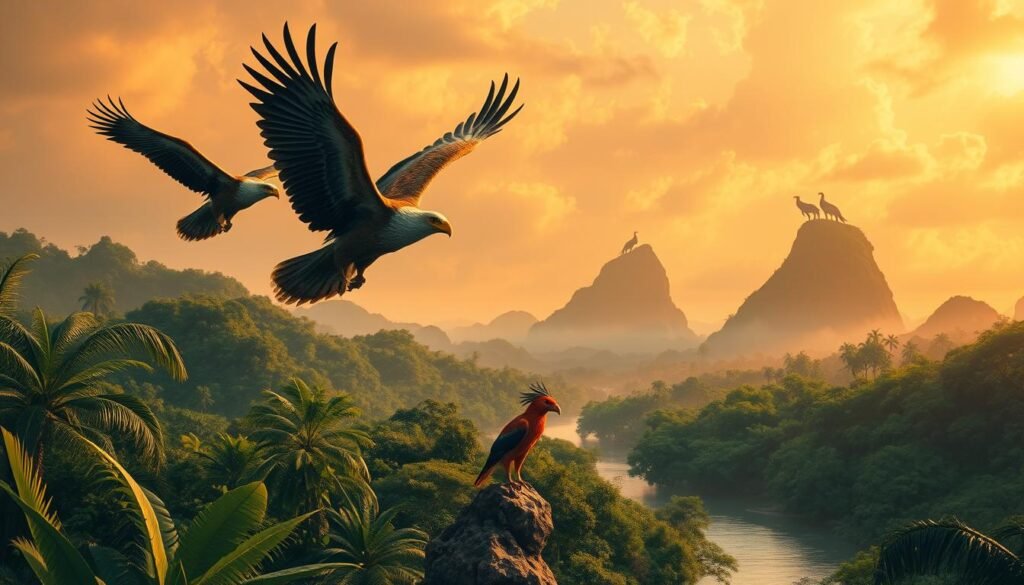
Mythology and Rituals
In pre-colonial Philippine myths, creatures like birds and frogs were seen as divine messengers. For example, the tikling bird was believed to guide lost souls, while the frog symbolized rain and fertility. These stories were more than tales; they were lessons about life and the universe.
Rituals often incorporated animal imagery to invoke blessings. Vertebrates like dogs and invertebrates like insects played key roles. A dog might be used in ceremonies to ensure prosperity, while insects were seen as carriers of messages from the spirit world.
Spiritual Connections to Nature
Early Filipinos viewed the environment as sacred. Land and water were not just resources but spiritual entities. Rituals often involved offerings to these elements, ensuring a balance between humans and nature.
For instance, during planting seasons, communities performed ceremonies to honor the land. These practices highlighted the dual role of creatures—both as physical beings and metaphors for cosmic order.
| Animal | Symbolism | Ritual Use |
|---|---|---|
| Bird | Guidance, Freedom | Used in ceremonies for safe journeys |
| Frog | Rain, Fertility | Invoked during planting seasons |
| Insect | Messages, Transformation | Included in rituals for spiritual clarity |
These traditions show how deeply intertwined early Filipinos were with their environment. The reverence for creatures of the land and water continues to inspire modern reflections on cultural heritage.
Animals: Classification and Cultural Symbolism
The classification of living beings played a pivotal role in shaping pre-colonial Philippine culture. Indigenous communities categorized creatures based on observable traits like size, movement, and habitat. These groupings were not just practical but also deeply symbolic, reflecting their spiritual connection to the natural world.
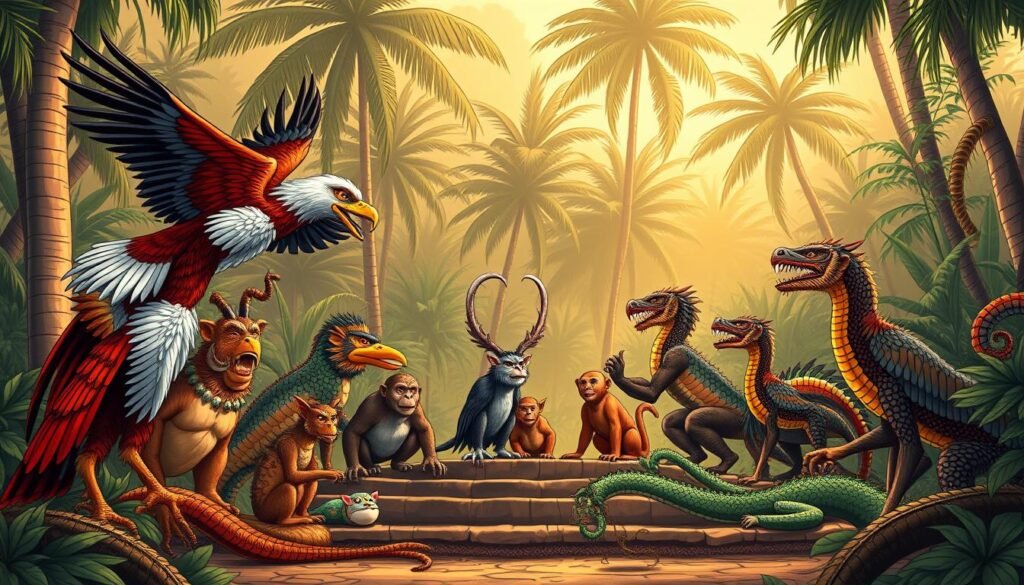
Vertebrates and Invertebrates in Folk Beliefs
Early Filipinos distinguished between vertebrates and invertebrates, each group carrying unique cultural meanings. Vertebrates, such as birds and mammals, often symbolized strength and guidance. Invertebrates, like insects and mollusks, were seen as messengers of transformation and spiritual clarity.
For example, the tikling bird was revered for its agility and grace, while insects like butterflies represented renewal. These distinctions were more than biological; they were woven into rituals and stories, offering lessons about life and the cosmos.
Sacred Species and Their Attributes
Certain species held sacred status in pre-colonial beliefs. The whale, for instance, was seen as a guardian of the seas, embodying power and mystery. Smaller creatures, like the frog, symbolized rain and fertility, essential for agricultural success.
Naming was also significant. Each name carried deep symbolic value, often reflecting the creature’s role in myths or rituals. This practice highlighted the interconnectedness of language, culture, and nature.
| Species | Symbolism | Cultural Role |
|---|---|---|
| Whale | Guardian, Power | Protector of the seas |
| Frog | Rain, Fertility | Invoked during planting |
| Butterfly | Renewal, Transformation | Symbol of spiritual change |
These traditions show how early Filipinos used classification to understand and honor the natural world. Their reverence for living beings continues to inspire modern reflections on cultural heritage.
Traditional Depictions in Art and Oral Narratives
From cave walls to campfires, the pre-colonial Philippines celebrated the animalia through art and tales. These depictions were not just decorative but served as profound expressions of cultural and spiritual beliefs. Rock art, totems, and oral narratives preserved the essence of their connection to the natural world.
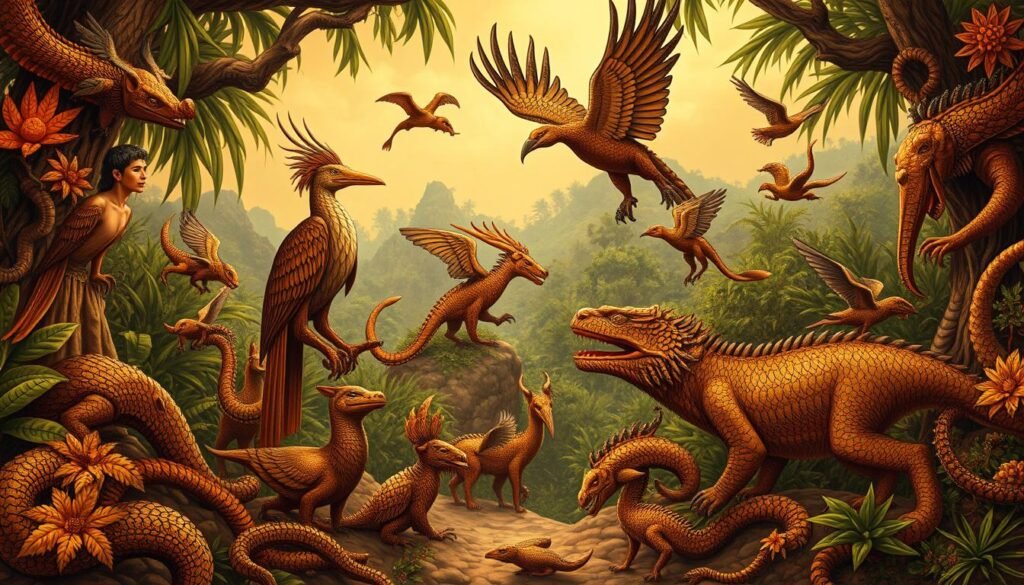
Cave Art and Totemic Representations
Ancient rock art in the Philippines often featured creatures like cats, reptiles, and birds. These images were central to spiritual narratives, symbolizing guidance, protection, and transformation. Totems, carved with animal traits, reinforced group identity and served as sacred symbols.
For example, the kingdom of living beings was often depicted in cave art, with each creature representing a specific attribute. This practice highlighted the interconnectedness of all life forms, from the smallest cell to the largest mammal.
Legends and Folklore Passed Through Generations
Oral traditions played a crucial role in preserving legends involving cats, reptiles, and other figures. These stories were more than entertainment; they conveyed moral lessons and cultural values. For instance, tales of the invertebrate butterfly symbolized renewal and transformation.
Storytellers used these narratives to teach respect for the natural world. The concept of a “kingdom” of living organisms was often used as a metaphor, emphasizing the balance and harmony of life.
These artistic and oral traditions deeply influenced religious rituals and daily practices. They remind us of the enduring legacy of pre-colonial Philippine culture and its reverence for the natural world.
Influence of Animal Traits on Societal Practices
In pre-colonial Philippines, the traits of mammals, fish, and amphibians shaped societal practices in profound ways. These creatures were not just part of the environment but also influenced hunting, domestication, and ceremonial rituals. Their behaviors and physical characteristics provided a blueprint for survival and spiritual expression.
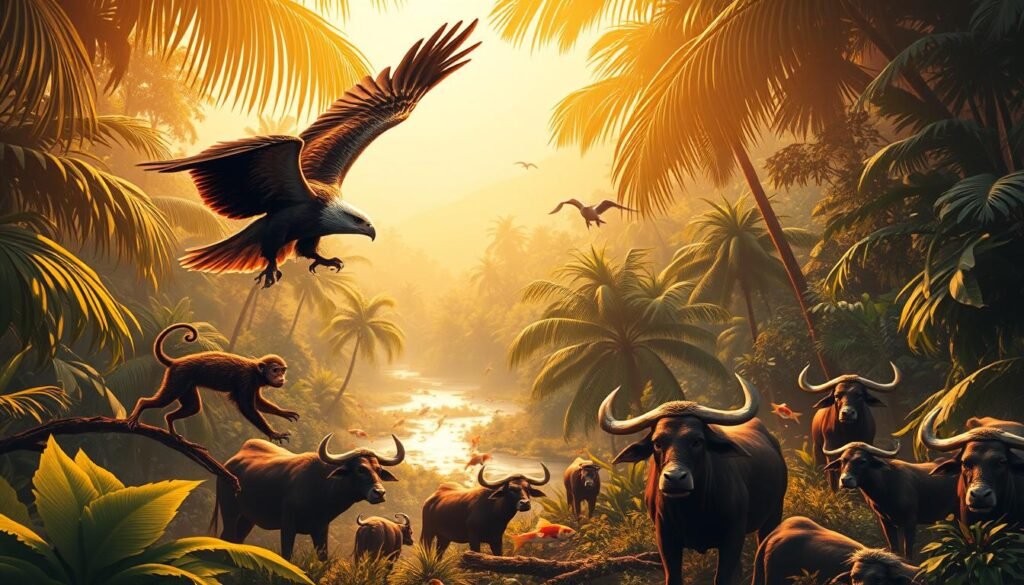
Hunting Traditions and Domestication
Early Filipinos observed the behaviors of mammals and fish to develop effective hunting techniques. For example, the agility of deer and the stealth of certain vertebrates inspired strategies for tracking and trapping. Similarly, the movement patterns of amphibians in water were studied to improve fishing methods.
Domestication was another area where animal traits played a key role. The docile nature of certain mammals made them ideal for farming and companionship. This process not only ensured food security but also strengthened the bond between humans and the natural world.
Symbolic Uses in Ceremonies and Rituals
Animal traits were also symbolically significant in ceremonies. The strength of a mammal might be invoked in rituals for protection, while the grace of a fish could symbolize prosperity. Different types of creatures, from insects to vertebrates, were represented in costumes and dances to honor their spiritual roles.
For instance, the mimicry of amphibian movements in dance was believed to bring rain and fertility. These practices highlight how deeply animal traits were woven into the cultural fabric of pre-colonial societies.
“The natural world was a teacher, and its creatures were the lessons.”
These traditions remind us of the intricate relationship between humans and the environment. To learn more about the social behaviors of animals, visit this resource. For insights into how domestication shaped animal behavior, explore this study.
Animals in Pre-Colonial Ceremonies and Community Life
In pre-colonial Philippine communities, festivals and rituals were deeply intertwined with the natural world, using animal motifs to celebrate life and renewal. These events were not just social gatherings but spiritual expressions of the community’s connection to the earth and its living beings. Animal imagery played a central role, symbolizing prosperity, freedom, and the eternal cycle of nature.

Cultural Festivals and Animal Imagery
Festivals often revolved around animal themes, reflecting the community’s respect for the natural world. Birds, for example, were seen as messengers of the spirit, embodying freedom and guidance. Their graceful movements were mimicked in dances, symbolizing the harmony between humans and nature.
Communal rituals also prominently featured animal imagery. The frog, a symbol of rain and fertility, was invoked during planting seasons to ensure a bountiful harvest. These practices highlighted the interconnectedness of the body of the community and the land they cultivated.
| Animal | Symbolism | Role in Festivals |
|---|---|---|
| Bird | Freedom, Spirit | Dances and ceremonies |
| Frog | Rain, Fertility | Planting rituals |
| Butterfly | Renewal, Transformation | Symbol of change |
These traditions were more than cultural expressions; they were lessons about the balance of life. The use of animal motifs in festivals underscored the community’s reverence for the natural world and its cycles. To learn more about the role of animals in pre-colonial Philippine beliefs, visit this resource.
Modern Reflections on Ancient Animal Beliefs
In today’s Philippines, ancient animal beliefs are finding new life in modern cultural expressions. From literature to visual arts, these traditions are being reinterpreted to resonate with contemporary audiences. This resurgence highlights the enduring connection between Filipinos and their natural environment.
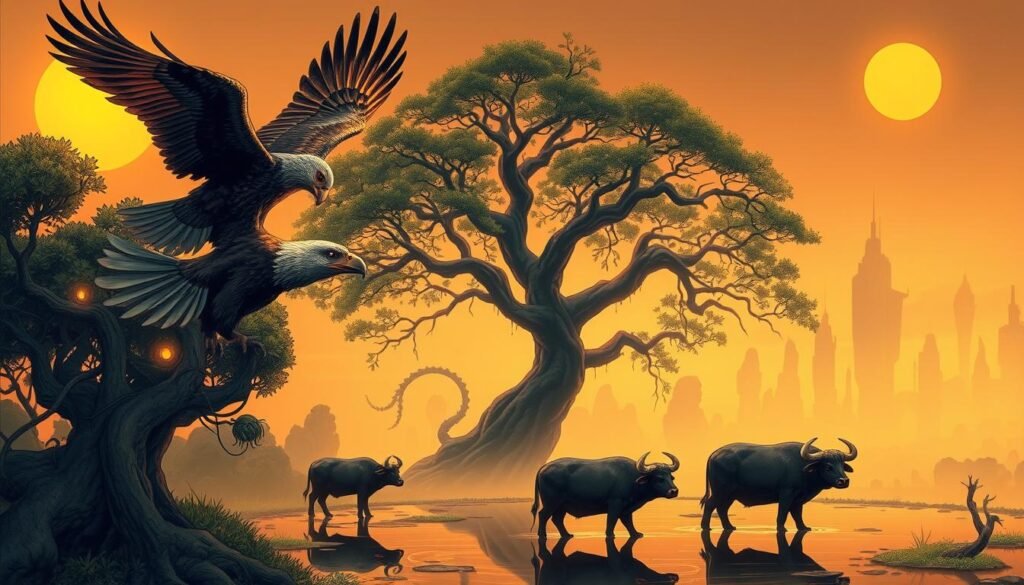
Revisiting Folklore in Contemporary Culture
Modern Filipinos are incorporating ancient myths into their creative works. For example, the frog, once a symbol of rain and fertility, now appears in eco-friendly campaigns. These adaptations show how traditional symbols are being reimagined to address current issues like climate change.
Cultural festivals also play a key role in keeping these beliefs alive. Events like the Ati-Atihan festival feature animal motifs, blending ancient traditions with modern celebrations. These festivals serve as a reminder of the deep-rooted connection between Filipinos and their natural system.
“The past is not just history; it’s a living part of our culture.”
Media productions are another platform for these reinterpretations. Films and TV shows often draw from folklore, using animal symbolism to tell compelling stories. This trend reflects a growing interest in preserving cultural heritage while adapting it for today’s audiences.
Environmental awareness has also influenced these modern reflections. As Filipinos become more conscious of their impact on the environment, ancient beliefs about harmony with nature gain new relevance. This shift is evident in art and literature that emphasize sustainability and ecological balance.
Comparing historical and modern artistic depictions reveals a continuous thread of animal significance. While traditional art focused on tissue-level details, modern technology allows for more intricate recreations. This evolution underscores the timeless importance of these symbols in Filipino culture.
To explore more about the evolution of animal welfare beliefs, visit this resource.
Conclusion
The cultural fabric of pre-colonial Philippines was intricately woven with the symbolism of the natural world. From the sea to the land, creatures like the rabbit and others played a vital role in shaping narratives and societal practices. These beings were not just part of the environment but symbols of deeper truths, enriching art, folklore, and rituals.
Traditional depictions in art and oral narratives highlighted their significance, offering lessons about life and the cosmos. This connection between humans and nature continues to inspire modern interpretations, bridging the gap between ancient beliefs and contemporary environmental awareness.
Understanding these traditions can guide us in fostering a harmonious relationship with our surroundings. As we reflect on the past, we are reminded of the enduring relevance of these symbols in shaping cultural identity and ecological consciousness. For more insights, explore this resource on ancient Filipino culture.
FAQ
What role did animals play in pre-colonial Philippine beliefs?
Animals held significant roles in pre-colonial Philippine beliefs, often symbolizing spiritual connections, cultural values, and natural forces. They were integral to mythology, rituals, and daily life.
How were animals classified in pre-colonial Philippine culture?
Animals were often categorized based on their traits, such as vertebrates and invertebrates, and their symbolic meanings. Sacred species were revered for their unique attributes and spiritual significance.
What are some examples of sacred animals in pre-colonial Philippines?
Sacred animals included species like the Philippine eagle, which symbolized strength, and the carabao, representing hard work and resilience. These creatures were deeply embedded in folklore and rituals.
How were animals depicted in pre-colonial art and oral narratives?
Animals were depicted in cave art, totemic representations, and oral stories. These depictions often conveyed moral lessons, cultural values, and connections to the natural world.
How did animal traits influence societal practices in pre-colonial Philippines?
Animal traits influenced hunting traditions, domestication, and ceremonial practices. For example, the agility of certain species inspired hunting techniques, while their symbolic meanings enriched rituals.
What was the significance of animals in pre-colonial ceremonies?
Animals played central roles in ceremonies, often symbolizing fertility, protection, or prosperity. Their imagery was used in cultural festivals to honor ancestors and natural spirits.
How are ancient animal beliefs reflected in modern Philippine culture?
Ancient animal beliefs continue to influence contemporary culture through folklore, art, and traditions. They serve as a bridge between the past and present, preserving cultural heritage.
Source Links
- The folklore saving animals’ lives
- Philippines – Flora, Fauna, Ecosystems | Britannica
- Cultural achievements of pre-colonial Philippines
- Pre Colonial Life and Culture in the Philippines
- Animal
- Animal Classification: A Taxonomy for All Living Things
- Storytelling and Cultural Traditions
- Oral tradition | Storytelling, Cultural Preservation & Memory | Britannica
- Folk literature | Definition, Characteristics, Examples, Significance, & Facts | Britannica
- Animal Personality and Conservation: Basics for Inspiring New Research
- Sociality and Wild Animal Welfare: Future Directions
- How Do Technologies Affect How We See and Treat Animals? Extending Technological Mediation Theory to Human-animal Relations – Ethical Theory and Moral Practice
- Ritual Objects – National Museum
- Microsoft Word – James legacy paper 1.03.03.doc
- Localized management of non-indigenous animal domesticates in Northwestern China during the Bronze Age – Scientific Reports
- Prehistoric religion | Stone Age, Paleolithic, Mesolithic, Neolithic, & Facts | Britannica
- BBC – Religions – Christianity: Animal rights
- Conclusions and Recommendations – Animals as Sentinels of Environmental Health Hazards
- Conclusions and Recommendations – Use of Laboratory Animals in Biomedical and Behavioral Research

